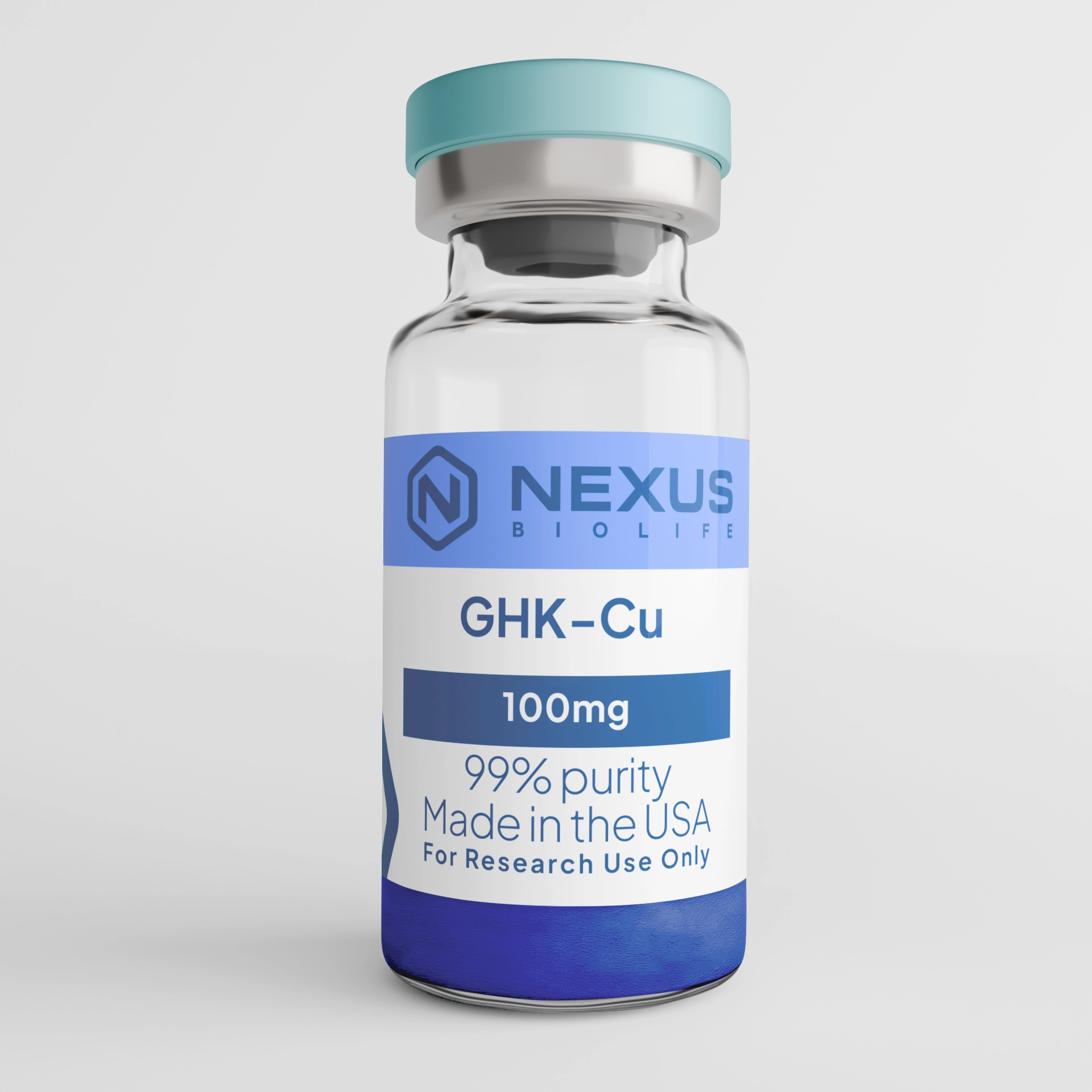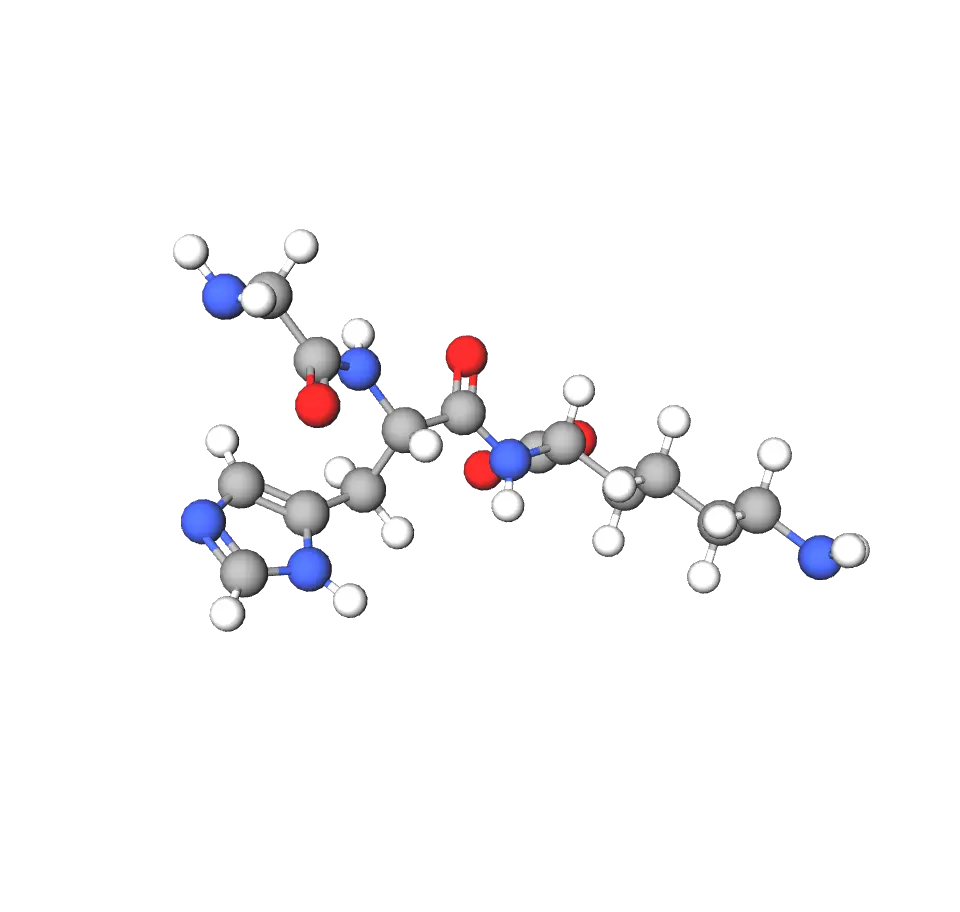
GHK-Cu is a synthetic peptide-copper complex meticulously prepared for scientific inquiry. This product is synthesized with high purity for laboratory investigations. It is developed for use in various research applications. GHK-Cu is designated solely for research and development purposes.

The core structure of GHK-Cu is the tripeptide sequence Gly-His-Lys, where the histidine residue facilitates a high-affinity coordination with copper(II) ions, forming a stable complex with a molecular weight of approximately 403 Da. This binding involves the imidazole nitrogen of histidine, the amino group of glycine, and the deprotonated amide nitrogen, creating a square-planar geometry that enhances the peptide's bioavailability and resistance to degradation in buffered solutions. Unlike larger peptides, its compact size allows for efficient diffusion in cellular assays, and modifications like liposomal encapsulation can further improve stability for extended experiments.
In lab settings, GHK-Cu is often provided as a blue lyophilized powder due to the copper content, with purity levels exceeding 98% as confirmed by HPLC and mass spectrometry in our quality checks. It exhibits good solubility in aqueous media at neutral pH, but we recommend avoiding extreme conditions to preserve the copper coordination. Its natural occurrence in plasma at concentrations declining with age underscores its relevance in age-related research models, where it can be used to probe copper-dependent pathways without the complexities of larger proteins. Our focus on integrity means every batch is tested for consistency, so you can rely on it for reproducible results in your studies.
GHK-Cu, or glycyl-L-histidyl-L-lysine copper complex, is a naturally occurring tripeptide that binds strongly to copper ions, playing a key role in various biological processes such as tissue repair and cellular signaling in experimental models. Discovered in human plasma, this small peptide—consisting of just three amino acids—has been studied for its potential to influence extracellular matrix components and inflammatory responses, making it a compelling subject for in-vitro investigations into regeneration and homeostasis. As with all our peptides, GHK-Cu is intended solely for research and in-vitro use only—not for human consumption or any diagnostic or therapeutic purposes.
GHK-Cu operates primarily through its copper-mediated interactions, modulating gene expression and cellular pathways involved in repair and protection. It has been shown to upregulate genes for collagen, elastin, and glycosaminoglycans while suppressing inflammatory markers like TNF-α and IL-6, potentially via inhibition of NF-κB and p38 MAPK signaling. In cellular models, this leads to enhanced fibroblast function and reduced oxidative stress, as the complex acts as an antioxidant by quenching reactive oxygen species and boosting superoxide dismutase activity.
Further, GHK-Cu influences extracellular matrix remodeling by promoting angiogenesis and nerve outgrowth, which may involve interactions with growth factors like TGF-β. Its ability to reset gene activity—affecting over 4,000 human genes, with a balance of activation and suppression—suggests a broad regulatory role, often reverting expression patterns to those seen in healthier states. For example, in inflammatory models, it attenuates cytokine release and supports proteasome-mediated cellular cleansing. We find these mechanisms fascinating and are eager to help you explore them—perhaps by suggesting assays that highlight its copper-dependent effects in a straightforward way.
Ultimately, GHK-Cu represents a versatile tripeptide-copper complex with profound implications for understanding repair mechanisms, from gene modulation to antioxidant defense, offering researchers a window into natural regenerative processes. Its ability to influence multiple pathways underscores our enthusiasm for peptide science, and we're proud to provide it with the transparency and quality you deserve. Strictly for in-vitro research, GHK-Cu embodies our mission to foster discovery through reliable tools and friendly collaboration. Let's keep advancing knowledge together, one well-designed study at a time.
GHK-Cu's broad profile makes it ideal for in-vitro and ex-vivo studies in areas like skin biology, inflammation, and tissue engineering. In fibroblast cultures, it has been used to investigate collagen synthesis and wound healing dynamics, where it enhances protein production and reduces markers of fibrosis. Its anti-inflammatory properties shine in models of lung injury, such as those induced by lipopolysaccharide, where it mitigates cellular infiltration and cytokine storms.
Researchers have also applied GHK-Cu in hydrogel formulations to study controlled release and its impact on angiogenesis in burn or ulcer models, demonstrating accelerated epithelialization and reduced oxidative damage. In gene expression assays, it's a tool for probing anti-aging pathways, as it modulates DNA repair and suppresses metastatic gene signatures in cancer cell lines. Antimicrobial conjugates of GHK have shown promise in infection models, highlighting its versatility beyond regeneration. We support these explorations with resources like protocol guides, because empowering your research with clear insights is what drives us.
To ensure GHK-Cu performs optimally in your experiments, store the lyophilized powder at -20°C in a dry, dark environment to maintain the copper complex's stability. For reconstitution, use sterile distilled water or a neutral buffer to achieve concentrations around 1-10 mM, gently mixing to avoid disrupting the metal binding—vigorous agitation can lead to precipitation.
Reconstituted solutions are best used fresh but can be aliquoted and stored at 4°C for short periods or frozen for longer-term use, though repeated freeze-thaw cycles should be minimized. Our testing confirms resilience under these conditions, but always monitor for color changes indicating oxidation. If you need advice on optimizing for specific assays, our team is here with logical, step-by-step suggestions.
GHK-Cu, or glycyl-L-histidyl-L-lysine copper complex, is a naturally occurring tripeptide that binds strongly to copper ions, playing a key role in various biological processes such as tissue repair and cellular signaling in experimental models. Discovered in human plasma, this small peptide—consisting of just three amino acids—has been studied for its potential to influence extracellular matrix components and inflammatory responses, making it a compelling subject for in-vitro investigations into regeneration and homeostasis. As with all our peptides, GHK-Cu is intended solely for research and in-vitro use only—not for human consumption or any diagnostic or therapeutic purposes.
GHK-Cu operates primarily through its copper-mediated interactions, modulating gene expression and cellular pathways involved in repair and protection. It has been shown to upregulate genes for collagen, elastin, and glycosaminoglycans while suppressing inflammatory markers like TNF-α and IL-6, potentially via inhibition of NF-κB and p38 MAPK signaling. In cellular models, this leads to enhanced fibroblast function and reduced oxidative stress, as the complex acts as an antioxidant by quenching reactive oxygen species and boosting superoxide dismutase activity.
Further, GHK-Cu influences extracellular matrix remodeling by promoting angiogenesis and nerve outgrowth, which may involve interactions with growth factors like TGF-β. Its ability to reset gene activity—affecting over 4,000 human genes, with a balance of activation and suppression—suggests a broad regulatory role, often reverting expression patterns to those seen in healthier states. For example, in inflammatory models, it attenuates cytokine release and supports proteasome-mediated cellular cleansing. We find these mechanisms fascinating and are eager to help you explore them—perhaps by suggesting assays that highlight its copper-dependent effects in a straightforward way.
Ultimately, GHK-Cu represents a versatile tripeptide-copper complex with profound implications for understanding repair mechanisms, from gene modulation to antioxidant defense, offering researchers a window into natural regenerative processes. Its ability to influence multiple pathways underscores our enthusiasm for peptide science, and we're proud to provide it with the transparency and quality you deserve. Strictly for in-vitro research, GHK-Cu embodies our mission to foster discovery through reliable tools and friendly collaboration. Let's keep advancing knowledge together, one well-designed study at a time.
The core structure of GHK-Cu is the tripeptide sequence Gly-His-Lys, where the histidine residue facilitates a high-affinity coordination with copper(II) ions, forming a stable complex with a molecular weight of approximately 403 Da. This binding involves the imidazole nitrogen of histidine, the amino group of glycine, and the deprotonated amide nitrogen, creating a square-planar geometry that enhances the peptide's bioavailability and resistance to degradation in buffered solutions. Unlike larger peptides, its compact size allows for efficient diffusion in cellular assays, and modifications like liposomal encapsulation can further improve stability for extended experiments.
In lab settings, GHK-Cu is often provided as a blue lyophilized powder due to the copper content, with purity levels exceeding 98% as confirmed by HPLC and mass spectrometry in our quality checks. It exhibits good solubility in aqueous media at neutral pH, but we recommend avoiding extreme conditions to preserve the copper coordination. Its natural occurrence in plasma at concentrations declining with age underscores its relevance in age-related research models, where it can be used to probe copper-dependent pathways without the complexities of larger proteins. Our focus on integrity means every batch is tested for consistency, so you can rely on it for reproducible results in your studies.

GHK-Cu's broad profile makes it ideal for in-vitro and ex-vivo studies in areas like skin biology, inflammation, and tissue engineering. In fibroblast cultures, it has been used to investigate collagen synthesis and wound healing dynamics, where it enhances protein production and reduces markers of fibrosis. Its anti-inflammatory properties shine in models of lung injury, such as those induced by lipopolysaccharide, where it mitigates cellular infiltration and cytokine storms.
Researchers have also applied GHK-Cu in hydrogel formulations to study controlled release and its impact on angiogenesis in burn or ulcer models, demonstrating accelerated epithelialization and reduced oxidative damage. In gene expression assays, it's a tool for probing anti-aging pathways, as it modulates DNA repair and suppresses metastatic gene signatures in cancer cell lines. Antimicrobial conjugates of GHK have shown promise in infection models, highlighting its versatility beyond regeneration. We support these explorations with resources like protocol guides, because empowering your research with clear insights is what drives us.
To ensure GHK-Cu performs optimally in your experiments, store the lyophilized powder at -20°C in a dry, dark environment to maintain the copper complex's stability. For reconstitution, use sterile distilled water or a neutral buffer to achieve concentrations around 1-10 mM, gently mixing to avoid disrupting the metal binding—vigorous agitation can lead to precipitation.
Reconstituted solutions are best used fresh but can be aliquoted and stored at 4°C for short periods or frozen for longer-term use, though repeated freeze-thaw cycles should be minimized. Our testing confirms resilience under these conditions, but always monitor for color changes indicating oxidation. If you need advice on optimizing for specific assays, our team is here with logical, step-by-step suggestions.
